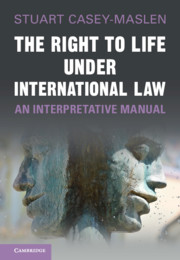Book contents
- The Right to Life under International Law
- The Right to Life under International Law
- Copyright page
- Contents
- Foreword
- Acknowledgements
- Table of Cases
- An Historical Introduction to the Right to Life
- Part I Overview of the Right to Life under International Law
- Part II Major Themes
- Part III The Protection of At-Risk Groups and Individuals
- 21 Women
- 22 Children
- 23 Racially Motivated Killings
- 24 LGBTI Persons
- 25 Persons with Disabilities
- 26 Older Persons
- 27 Journalists
- 28 Human Rights Defenders
- 29 International Migrants
- 30 Internally Displaced Persons
- 31 Refugees
- Part IV Accountability
- Part V Human Rights Machinery Protecting the Right to Life
- Part VI Outlook
- Index
30 - Internally Displaced Persons
from Part III - The Protection of At-Risk Groups and Individuals
Published online by Cambridge University Press: 02 September 2021
- The Right to Life under International Law
- The Right to Life under International Law
- Copyright page
- Contents
- Foreword
- Acknowledgements
- Table of Cases
- An Historical Introduction to the Right to Life
- Part I Overview of the Right to Life under International Law
- Part II Major Themes
- Part III The Protection of At-Risk Groups and Individuals
- 21 Women
- 22 Children
- 23 Racially Motivated Killings
- 24 LGBTI Persons
- 25 Persons with Disabilities
- 26 Older Persons
- 27 Journalists
- 28 Human Rights Defenders
- 29 International Migrants
- 30 Internally Displaced Persons
- 31 Refugees
- Part IV Accountability
- Part V Human Rights Machinery Protecting the Right to Life
- Part VI Outlook
- Index
Summary
IDPs are especially vulnerable to human trafficking, to forced recruitment, to sexual violence, and to falling prey to landmines or unexploded ordnance. IDPs are far more at risk from explosive ordnance than are settled communities because they do not know which areas or which routes are safe and which are not. Some of the typical needs and protection risks that arise in internal displacement include family separation, loss of documentation, freedom of movement in and out of camps, loss of property, and further exposure to the risk of secondary or onward displacement. The United Nations Guiding Principles on Internal Displacement have not been turned into a legally binding instrument, although many of the Principles reflect customary law. The African Union Convention for the Protection and Assistance of Internally Displaced Persons in Africa (Kampala Convention) is the only continental treaty dedicated to the protection of IDPs.
Keywords
- Type
- Chapter
- Information
- The Right to Life under International LawAn Interpretative Manual, pp. 594 - 600Publisher: Cambridge University PressPrint publication year: 2021
- 1
- Cited by



